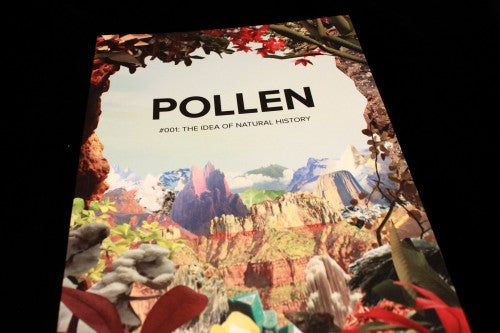
Out now: Pollen #1

The first issue of Pollen is somewhere between being a book, a magazine, a collage, an art catalogue and a science museum brochure. The publication has been put together by a group of philosophy graduate students from the University of Sydney; inspired by their studies they decided to entitle the first issue ‘The Idea of Natural History’, a theme which stems from the theories of Theodore Adorno.
Put briefly, the issue uses Adorno’s concept of ‘Natural History’ to suggest ways in which the opposing forces of nature and history are brought together. The philosophy is dealt with in an approachable and engaging way, similar to the recent Table Talk that has been generating a lot of excitement (read our interview), and the content reads like a love-letter to the German Frankfurt School of philosophers. Modern philosophy and critical theory is written about with that same kind of energy and fascination that you’d usually associate with music zines – and this tied together with a tactile and visually stimulating design makes Pollen one of those magazines that doesn’t shift from your bedside reading table for quite a while.

Designed by Mike Deal, the illustrations are collages of images from habitat dioramas at the American Museum of Natural History. This gives the pages a very textured and solid look; well suited to the magazine’s interest in the organic realm (above). A spread that pairs precious rocks and stones with the best minds in history, from Ovid to Goethe to Sebald to Herzog, is particularly pleasing (below).


One piece about a mysterious two-metre prehistoric spiral found in East Sussex in 1921 makes particularly good use of collage (above). As the article feeds our fascination and curiosity, the accompanying illustration fragments and distorts, reconfiguring the way nature looks as we simultaneously re-configure how we think about the prehistoric form.

A montage of images and textures also accompanies a piece about Walter Benjamin and his theories of montage – this subtle parallel between content and imagery helps readers visually comprehend the words (above).

The juxtaposition between the white space of the page and the nature imagery throughout is particularly unusual and eye-catching: sections of plant-life seem to open up from within the magazine like a portal (above), an abstract response to the words that gives the publication a playful dimension.
At the back of the magazine there are book reviews of art books related to the theme, and album reviews of ambient bands with textured, minimal album covers and names like ‘Soil’. Pollen is not an academic journal or a conventional magazine either; it’s the best of both worlds - playful, concise and intellectually provocative.
Issue two, ‘Creaturely Life’, will be released later this year.
Review by Madeleine Morley


